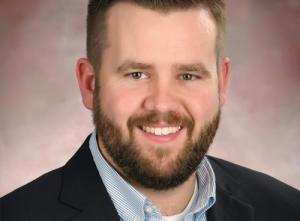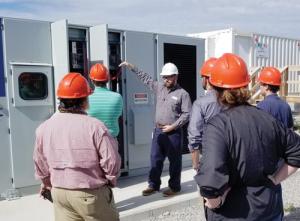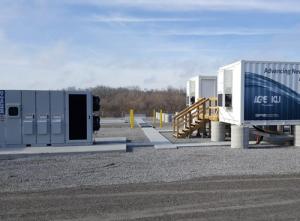Fortnightly Top Innovators 2018
Nick Jewell is Senior Research Engineer – LG&E and KU.
Steve Mitnick is Editor-in-Chief of Public Utilities Fortnightly and President of Lines Up, Inc.
PUF: What's this project about?

Nick Jewell: I'm in research and development. Energy storage has been on our radar as something that's getting very close to a mature technology. We decided to design an energy storage research and development project and co-locate with our ten-megawatt solar facility, after it was built. The solar facility began commercial operation in 2016. We repurposed the construction lay-down yard used during construction for the battery storage site. The battery site began operation in December of 2016.
The site was designed to be technology agnostic. We can test most types of energy storage including lithium ion batteries, flow batteries, mechanical systems such as flywheels, and electrical systems such as capacitors or solid-state batteries, when those near commercialization.
We wanted the site to be modular so that we could bring storage systems in, as well as balance-of-plant equipment, including inverters and control systems, allowing for both short-term and long-term testing and evaluation. This design gained a lot of interest from the Electric Power Research Institute, other research agencies, system vendors, and universities. It allows us flexibility to test a multitude of items on a collaborative platform.
It's a best-in-class testing site that is fully instrumented for detailed evaluation and characterization of energy storage. We have data collection capabilities down to sub-cycle samplings, so we can see things like system harmonics.
 Nick Jewell: It’s a best-in-class testing site [for] energy storage. We have data collection capabilities down to sub-cycle samplings, so we can see things like system harmonics.
Nick Jewell: It’s a best-in-class testing site [for] energy storage. We have data collection capabilities down to sub-cycle samplings, so we can see things like system harmonics.
We started working with EPRI on this project. Through our partnership with them, we procured the first battery system that we have on site. It's a one megawatt, two megawatt-hour lithium ion system. We've been using that to characterize the site and verify capabilities. We've also been using it to learn more about the technology. With energy storage growing, it is important to stay on top of the changing technologies.
PUF: What are you testing and looking for?
Nick Jewell: We're looking at a number of things. The big unknown right now is about the performance and reliability of these systems. The technology is still somewhat new.
For example, if you ask somebody in the utility about a transformer, he or she could tell you everything about it including performance and reliability. But if you ask about a battery system, you most likely won't get that same response.
 Nick Jewell: The battery site began operation in December of 2016.
Nick Jewell: The battery site began operation in December of 2016.
We're just trying to learn how these systems behave. What are some of their characteristics? How do they hold charge? What are their response times? For reliability factors, what is the mean time-to-failure or types of repairs for an average system?
PUF: I've heard that some of these systems degrade in their performance over time, so how do you combat that?
Nick Jewell: Degradation depends on the use-case and the storage technology. If your system is providing frequency response, or providing voltage regulation, the system degrades faster than if it was just providing bulk-energy shifting. The more charge and discharge cycles that the system is subjected to, the more degradation you have. Various types of storage have different degradation mechanisms and it is important to capture this.
Performance and degradation is a key focus with our studies. That's why we're pulling in some of the local universities and collaborating on modeling efforts.
Unfortunately these factors will take several years of operational experience to discover. However, based on how the system performs in the near term, we can build models and then simulate advanced cycling. A simulation can take an hour, but it can simulate ten years of run time. We can see what that degradation is forecasted to look like.
PUF: Were there some challenges that you and the team had to overcome?
Nick Jewell: Yes, there have been a lot, as there typically are with most research and development projects due to the unknowns. We've encountered issues all the way from the construction process, to delivery of equipment, to the commissioning and operations processes.
Planning and design meetings were held during evenings and early mornings due to the international nature of the project teams. Sometimes, language barriers were even a factor.
Many of the controls that we have implemented on this system are unique and one-of-a-kind, because we wanted to test the system and push the limits of what storage can do as well as see what our site can handle. A lot of the controls were built and programmed on site.
Finally, having teams of experts, researchers, and engineers from across the country working remotely with myself and the site, which is located in rural Kentucky, it became an IT challenge trying to get everybody connected and get them in securely. Utilities lock down everything like Fort Knox, because of security. That's another challenge, getting that virtual connection so that everybody can work together.
PUF: What do you see going forward over the next two or three years, with this project?
Nick Jewell: There are a couple of things. The site has three testing bays, but we only have one system installed currently. We are working with another vendor to bring a second system in for Underwriters' Laboratory (UL) testing, so the vendor can take the system and market it in the United States as a modular, packaged system. We'd be partnering with that company and also with a certified testing agency, to perform that certification testing.
Leaning on vendors to bring their systems to our site for testing is one route that we're taking. Another route is through our partnership with EPRI. I'm heavily involved in their energy storage program and we are looking at developing a project that utilities can participate in, to leverage each other's funding, and collaboratively bring in new technologies to evaluate.
The next system that we're looking at bringing in is a flow battery system, which operates a little differently than a traditional battery system. Flow batteries utilize large electrolyte tanks and a cell stack and contain pumps and valves that circulate the electrolyte. It's more of a chemical plant than a battery system.
With the partnership with EPRI, as new technologies come out, like new mechanical systems, flywheels, or compressed air storage, or any modular-type storage system, we could bring it on site, characterize it, compare it to other technologies, use that to feed information back to equipment vendors that are supplying it, and eventually make a better product.
During that time, any utilities that partner on that project get the data, and the operational experience. They get to see the system first hand and get to play with it. It benefits everybody in the end.
Profiles in Innovation:
- Richard Barone, Director - Demand Response, Hawaiian Electric Utilities
- Howard Gugel, Senior Director - Engineering and Standards, NERC
- Nick Jewell, Senior Research Engineer - LG&E and KU
- Kent Larson, President - Group Operations and Executive VP, Xcel Energy
- Yi Li, Senior Engineer - Distribution Operation, PPL Electric Utilities
- Mychal Kistler, Relay and Protection Technician, PPL Electric Utilities
- Brent McKinney, Director - Electric Transmission and Distribution, City Utilities of Springfield
- Saul Rojas, VP - Technical Compliance, New York Power Authority
- Guy Sliker, Director - Energy Services Product Development, New York Power Authority
- Ben Stanford, Senior Director - Water Intelligence, Technology and Innovation, American Water
- Gary Stockbridge, Region President - Atlantic City Electric and Delmarva Power
- Mike Poncia, Vice President - Customer Operations, Pepco Holdings
- Tracy Orledge, Business Analyst, Pepco Holdings



